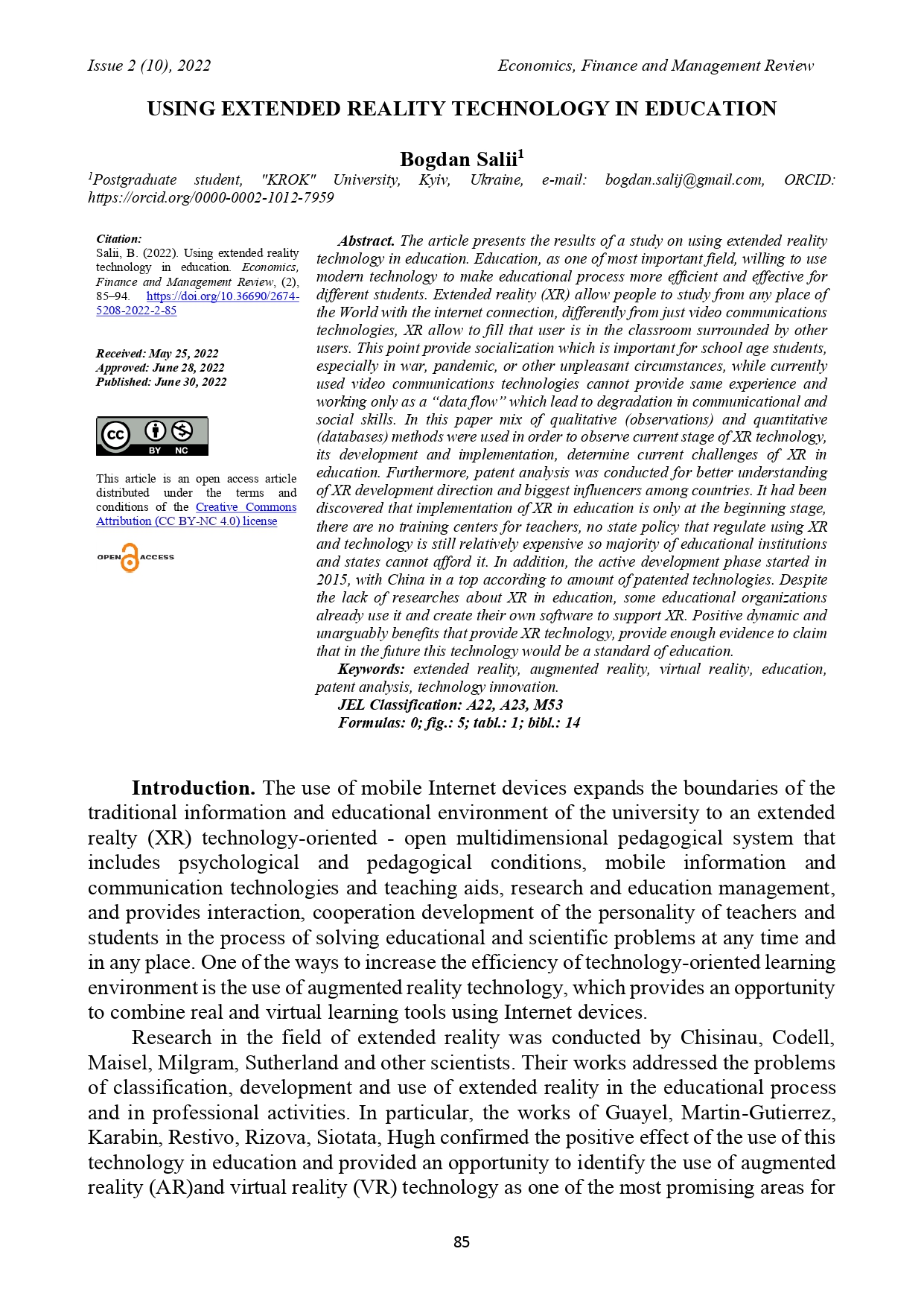USING EXTENDED REALITY TECHNOLOGY IN EDUCATION
DOI:
https://doi.org/10.36690/2674-5208-2022-2-85Keywords:
extended reality, augmented reality, virtual reality, education, patent analysis, technology innovationAbstract
The article presents the results of a study on using extended reality technology in education. Education, as one of most important field, willing to use modern technology to make educational process more efficient and effective for different students. Extended reality (XR) allow people to study from any place of the World with the internet connection, differently from just video communications technologies, XR allow to fill that user is in the classroom surrounded by other users. This point provide socialization which is important for school age students, especially in war, pandemic, or other unpleasant circumstances, while currently used video communications technologies cannot provide same experience and working only as a “data flow” which lead to degradation in communicational and social skills. In this paper mix of qualitative (observations) and quantitative (databases) methods were used in order to observe current stage of XR technology, its development and implementation, determine current challenges of XR in education. Furthermore, patent analysis was conducted for better understanding of XR development direction and biggest influencers among countries. It had been discovered that implementation of XR in education is only at the beginning stage, there are no training centers for teachers, no state policy that regulate using XR and technology is still relatively expensive so majority of educational institutions and states cannot afford it. In addition, the active development phase started in 2015, with China in a top according to amount of patented technologies. Despite the lack of researches about XR in education, some educational organizations already use it and create their own software to support XR. Positive dynamic and unarguably benefits that provide XR technology, provide enough evidence to claim that in the future this technology would be a standard of education.
Downloads
References
ABI Research. (2021). AR Remote Expertise and Training Applications. Retrieved from: https://www.abiresearch.com/press/ ar-remote-expertise-and-training-applications-have-almost-60-million-active-users-2025/
Cecilia, A. G. (2021). Augmented Reality in Education: An Overview of Twenty-Five Years of Research. Cont Ed Technology, vol. 13. P. 13. Retrieved from: https://doi.org/10.30935/cedtech/10865
Cieutat, JM. (2012). Active Learning based on the use of Augmented Reality Outline of Possible Applications: Serious Games, Scientific Experiments, Confronting Studies with Creation, Training for Carrying out Technical Skills. International Journal of Computer Applications, vol. 17. pp. 96-108.
Fiani, B.; De Stefano, F.; Kondilis, A.; Covarrubias, C.; Reier, L.; Sarhadi, K. (2020).Virtual Reality in Neurosurgery: “Can You See It?”—A Review of the Current Applications and Future Potential. World Neurosurg, vol 141. pp. 291–298.
Karabin, O. (2019). Technology of augmented reality in the educational environment of higher education institutions. Modern information technologies and innovative teaching method. Materials of the IV International Scientific and Practical Internet Conference. Ternopil, November 7-8. pp. 107-110.
Khor, WS.; Baker, B.; Amin, K.; Chan, A.; Patel, K.; Wong, J. (2016). Augmented and virtual reality in surgery-the digital surgical environment: Applications, limitations and legal pitfalls. The Annals of Translational Medicine, vol 4. pp. 454-455.
Li, D. (2019). 5G and intelligence medicine-how the next generation of wireless technology will reconstruct healthcare? Precision Clinical Medicine, vol 2. pp. 205–208.
Martin-Gutierrez, J. (2014). Improving strategy of self-learning in engineering. Scientific notes series: Problems of physical and mathematical methods, vol. 11. pp. 832-839.
Milgram, PA. (1994). Taxonomy of mixed reality visual displays. IEICE Transactions on Information Systems, vol. E77-D. pp. 1321-1329.
Nekrasov, V. (2020). The facets of 5G: soon people will not be able to distinguish the virtual world from the physical. Economic truth, vol. 8. pp. 267-271.
Restivo, MT. (2016). Augmented Reality in Electrical Fundamentals. International Journal of Online Engineering, vol. 10. pp. 68-72.
Rizov, T. (2017). Augmented reality as a teaching tool in higher education. International Journal of Cognitive Research in Science, Engineering and Education, vol. 3. pp. 7-16.
Sutherland, IE. (1968). A head-mounted three dimensional display. Fall Joint Computer Conference. December 9-11. Washington : Thompson Books. pp. 757-764.
World Bank. (2020). Digital Technologies in Education. Remote Learning, EdTech & COVID-19. pp. 7-21.

Downloads
Published
How to Cite
Issue
Section
License

This work is licensed under a Creative Commons Attribution-NonCommercial 4.0 International License.








